AMD's Radeon HD 5870: Bringing About the Next Generation Of GPUs
by Ryan Smith on September 23, 2009 9:00 AM EST- Posted in
- GPUs
Eyefinity
Somewhere around 2006 - 2007 ATI was working on the overall specifications for what would eventually turn into the RV870 GPU. These GPUs are designed by combining the views of ATI's engineers with the demands of the developers, end-users and OEMs. In the case of Eyefinity, the initial demand came directly from the OEMs.
ATI was working on the mobile version of its RV870 architecture and realized that it had a number of DisplayPort (DP) outputs at the request of OEMs. The OEMs wanted up to six DP outputs from the GPU, but with only two active at a time. The six came from two for internal panel use (if an OEM wanted to do a dual-monitor notebook, which has happened since), two for external outputs (one DP and one DVI/VGA/HDMI for example), and two for passing through to a docking station. Again, only two had to be active at once so the GPU only had six sets of DP lanes but the display engines to drive two simultaneously.
ATI looked at the effort required to enable all six outputs at the same time and made it so, thus the RV870 GPU can output to a maximum of six displays at the same time. Not all cards support this as you first need to have the requisite number of display outputs on the card itself. The standard Radeon HD 5870 can drive three outputs simultaneously: any combination of the DVI and HDMI ports for up to 2 monitors, and a DisplayPort output independent of DVI/HDMI. Later this year you'll see a version of the card with six mini-DisplayPort outputs for driving six monitors.

It's not just hardware, there's a software component as well. The Radeon HD 5000 series driver allows you to combine all of these display outputs into one single large surface, visible to Windows and your games as a single display with tremendous resolution.
I set up a group of three Dell 24" displays (U2410s). This isn't exactly what Eyefinity was designed for since each display costs $600, but the point is that you could group three $200 1920 x 1080 panels together and potentially have a more immersive gaming experience (for less money) than a single 30" panel.
For our Eyefinity tests I chose to use every single type of output on the card, that's one DVI, one HDMI and one DisplayPort:
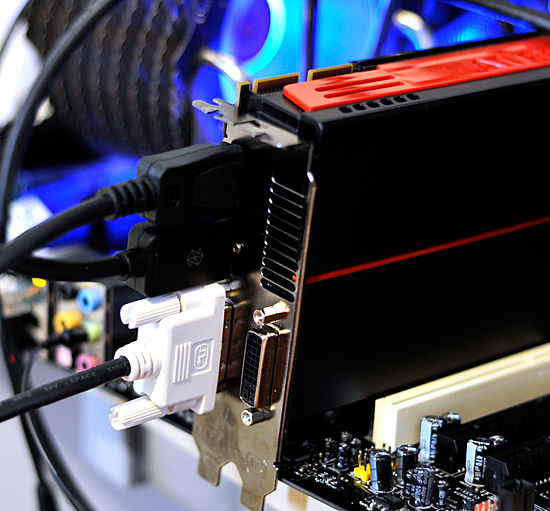
With all three outputs connected, Windows defaults to cloning the display across all monitors. Going into ATI's Catalyst Control Center lets you configure your Eyefinity groups:

With three displays connected I could create a single 1x3 or 3x1 arrangement of displays. I also had the ability to rotate the displays first so they were in portrait mode.

You can create smaller groups, although the ability to do so disappeared after I created my first Eyefinity setup (even after deleting it and trying to recreate it). Once you've selected the type of Eyefinity display you'd like to create, the driver will make a guess as to the arrangement of your panels.

If it guessed correctly, just click Yes and you're good to go. Otherwise ATI has a handy way of determining the location of your monitors:

With the software side taken care of, you now have a Single Large Surface as ATI likes to call it. The display appears as one contiguous panel with a ridiculous resolution to the OS and all applications/games:
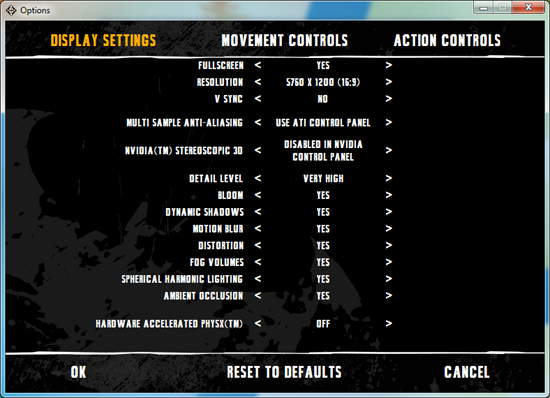
Three 24" panels in a row give us 5760 x 1200
The screenshot above should clue you into the first problem with an Eyefinity setup: aspect ratio. While the Windows desktop simply expands to provide you with more screen real estate, some games may not increase how much you can see - they may just stretch the viewport to fill all of the horizontal resolution. The resolution is correctly listed in Batman Arkham Asylum, but the aspect ratio is not (5760:1200 !~ 16:9). In these situations my Eyefinity setup made me feel downright sick; the weird stretching of characters as they moved towards the outer edges of my vision left me feeling ill.

Dispite Oblivion's support for ultra wide aspect ratio gaming, by default the game stretches to occupy all horizontal resolution
Other games have their own quirks. Resident Evil 5 correctly identified the resolution but appeared to maintain a 16:9 aspect ratio without stretching. In other words, while my display was only 1200 pixels high, the game rendered as if it were 3240 pixels high and only fit what it could onto my screens. This resulted in unusable menus and a game that wasn't actually playable once you got into it.
Games with pre-rendered cutscenes generally don't mesh well with Eyefinity either. In fact, anything that's not rendered on the fly tends to only occupy the middle portion of the screens. Game menus are a perfect example of this:
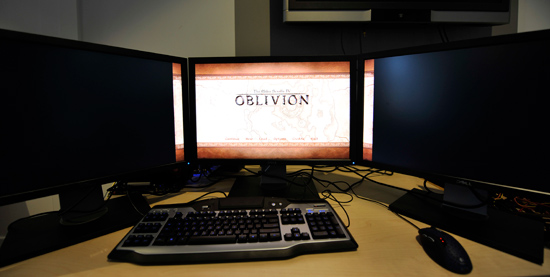
There are other issues with Eyefinity that go beyond just properly taking advantage of the resolution. While the three-monitor setup pictured above is great for games, it's not ideal in Windows. You'd want your main screen to be the one in the center, however since it's a single large display your start menu would actually appear on the leftmost panel. The same applies to games that have a HUD located in the lower left or lower right corners of the display. In Oblivion your health, magic and endurance bars all appear in the lower left, which in the case above means that the far left corner of the left panel is where you have to look for your vitals. Given that each panel is nearly two feet wide, that's a pretty far distance to look.
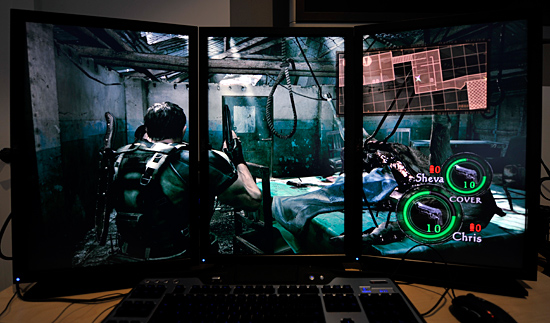
The biggest issue that everyone worried about was bezel thickness hurting the experience. To be honest, bezel thickness was only an issue for me when I oriented the monitors in portrait mode. Sitting close to an array of wide enough panels, the bezel thickness isn't that big of a deal. Which brings me to the next point: immersion.
The game that sold me on Eyefinity was actually one that I don't play: World of Warcraft. The game handled the ultra wide resolution perfectly, it didn't stretch any content, it just expanded my viewport. With the left and right displays tilted inwards slightly, WoW was more immersive. It's not so much that I could see what was going on around me, but that whenever I moved forward I I had the game world in more of my peripheral vision than I usually do. Running through a field felt more like running through a field, since there was more field in my vision. It's the only example where I actually felt like this was the first step towards the holy grail of creating the Holodeck. The effect was pretty impressive, although costly given that I only really attained it in a single game.
Before using Eyefinity for myself I thought I would hate the bezel thickness of the Dell U2410 monitors and I felt that the experience wouldn't be any more engaging. I was wrong on both counts, but I was also wrong to assume that all games would just work perfectly. Out of the four that I tried, only WoW worked flawlessly - the rest either had issues rendering at the unusually wide resolution or simply stretched the content and didn't give me as much additional viewspace to really make the feature useful. Will this all change given that in six months ATI's entire graphics lineup will support three displays? I'd say that's more than likely. The last company to attempt something similar was Matrox and it unfortunately didn't have the graphics horsepower to back it up.
The Radeon HD 5870 itself is fast enough to render many games at 5760 x 1200 even at full detail settings. I managed 48 fps in World of Warcraft and a staggering 66 fps in Batman Arkham Asylum without AA enabled. It's absolutely playable.
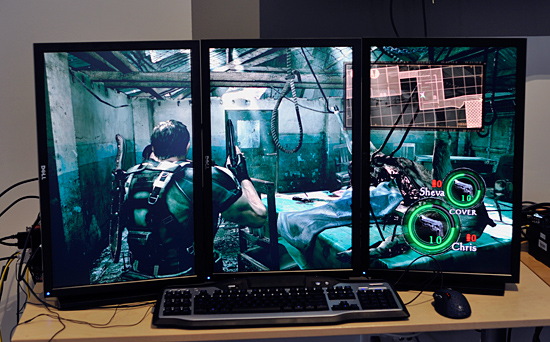










327 Comments
View All Comments
T2k - Thursday, September 24, 2009 - link
Just whatF are you talking about, seriously? Is this some kind of new urban BS again?
Look at other sites, they DID test it with ET:QW:
http://www.techpowerup.com/reviews/ATI/Radeon_HD_5...">http://www.techpowerup.com/reviews/ATI/Radeon_HD_5...
http://www.xbitlabs.com/articles/video/display/rad...">http://www.xbitlabs.com/articles/video/display/rad...
and so on. BTW L4D is a passing fart in the wind while ET:QW is still going strong, stronger than UT3 (unfortunately because UT3 looks 10x better and the old ONS mode was awesome but Epic fucked it in UT3)
Read other reviews before you post:
http://forums.anandtech.com/messageview.aspx?catid...">http://forums.anandtech.com/messageview...amp;thre...
SiliconDoc - Wednesday, September 30, 2009 - link
I see by your review links the 5870 just doesn't do well in ET:QW, everything else is closer to it and it gets beat worse, at 2560 high aa&af GTX295 slams it by 20%, so, of course, it was left out, in order to "pump up the percieved red number".-
It's "not a good appearance".
You'll just have to live with it for now like the rest of us.
number58 - Wednesday, September 23, 2009 - link
Is this card any closer to saturating the pci-express 2.0 x16 slot? That was one of the big arguments in the P55 vs X58 debate. Would there be any loss of performance using these in crossfire on P55 compared to X58?Otherwise, great article. I think I'll be hanging on to my 4890 for a while though.
Kaleid - Wednesday, September 23, 2009 - link
Look here for an answer:http://www.techpowerup.com/reviews/AMD/HD_5870_PCI...">http://www.techpowerup.com/reviews/AMD/HD_5870_PCI...
number58 - Wednesday, September 23, 2009 - link
Thanks. That just about settles it. My next system will be Lynnfield based.Zeratul - Wednesday, September 23, 2009 - link
Please add support for Stereoscopic 3D, ATI. I'm not going back to play games in 2D, though I don't like nvidia's monopoly in that.Arbie - Wednesday, September 23, 2009 - link
Not just a review but an excellent technical discussion. It must have been a lot of work. Thanks for all of that, and do please follow up where you can on people's requests for more info on this very important card.Kudos to ATI/AMD for such an achievement. It looks like Nvidia is in big trouble.
Arbie
SiliconDoc - Wednesday, September 23, 2009 - link
rofl - Nvidia is in big trouble ? LOLHave you looked at the charts on wiki that predicted what this review shows ? Maybe you should take a gander at the Nvidia chart, now, and cry.
--
It is a nice review, although biased red here as usual.
--
I'd like to mention as he fretted about heat because of the 1/2 vent on the back of the card, I didn't notice overt despairing mention of the TWO rectangular exhaust ports on the fan end BLOWING HEAT INTO THE CASE.... which of course is deserved. Nice how that was held back as if overlooked. (Boy what trouble for Nvidia! hahha)
Next we'll be told the red rooster tester put his hand next to the two internal exhaust ports, and "the air felt rather cool" so "rest assured not much heat is being pushed into your case", and "this doesn't matter".
See, the trouble is already in the article, the trouble it took to spin it just so for Ati... lol... it's hilatrious!
ClownPuncher - Wednesday, September 23, 2009 - link
Bizzarro SnakeOil, is that you?SiliconDoc - Wednesday, September 23, 2009 - link
No, this is me, the same me I've always been.Would you like to comment on the two internal exhaust ports of the 5870 that put sweltering heat into your case ?
I guess you tried to ignore that entirely.
You can always insult me again and avoid commenting on the heating exhaust ports ramping up your case temps on the 5870...
That of course would be "the right thing to do".
Perhaps call me crazy, and avoid the topic, right, you're good at that, huh.